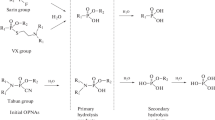Abstract
Atomic-emission detection (AED) is a technique particularly-well suited to screening complex samples for multiple compounds containing heteroatoms such as phosphorus, sulfur, or nitrogen, which are especially relevant in verification of chemical disarmament. Among other GC detectors, AED has unique characteristics such as compound-independent calibration and possible raw-formula determination. Because contradictory results have been reported on these points, we set up a study with the objectives not only of applying these techniques to chemical weapons convention-related chemicals but of determining under which conditions they would yield satisfactory results. The extensive data collected in this study are evidence that the response of the detector, particularly for the phosphorus line, is very dependent on the molecular mass and concentration of the chemicals analysed whereas molecular structure seems to have less effect on the AED signal. Most interestingly, compound-independent calibration and subsequent partial molecular formula determination usually seem satisfactory when the reference compounds used to calibrate the system have GC retention times and molecular masses close to those of the unknown analytes (whose molecular mass may be determined by GC–CI-MS). We therefore suggest the use of a reference set of compounds covering a large chromatographic window, which enables the selection, within this set, of the most appropriate reference compound for calibration and for determination of the raw formula of an unknown analyte. For optimal performance, the use of a new discharge tube is also recommended.



Similar content being viewed by others
References
McCormack AJ, Tong SG, Cooke WD (1965) Anal Chem 37:1470–1477
Van Stee LP, Brinkman UAT (2002) Trends Anal Chem 21:618–626; and references cited therein
Andersson JT (2002) Anal Bioanal Chem 373:344–355; and references cited therein
Wylie PL, Sullivan JJ, Quimby BD (1990) J High Res Chromatogr 13:499–506
Hardas NR, Uden PC (1999) J Chromatogr A 844:271–281
Gurkas DF, Pyle S, Titus R (1997) Anal Chem 69:2411–2417
Goosens EC, de Jong T, de Jong GJ, Rinkerna FD, Brinkman UAT (1995) J High Res Chromatogr 18:38–44
Schoene K, Steinhanses J, Bruckert HJ, König A (1992) J Chromatogr 605:257–262
Le Harle JP, Bellier B (2005) J Chromatogr A 1087:124–130
Creasy WR, Rodriguez AA, Stuff JR, Warren RW (1995) J Chromatogr A 709:333–344
Juillet Y, unpublished results
Weimaster JF, Beaudry WT, Bossle PC, Ellzy MW, Janes LG, Johnson DW, Lochner JM, Pleva SG, Reeder JH, Rohrbaugh DK, Rosso TE, Szafraniec LJ, Szafraniec LL, Albro TG, Creasy WR, Stuff JR, Smith PB, Stewart IR (1995) J Chem Technol Biotechnol 64:115–128
Brickhouse MD, Creasy WR, Williams BR, Morrissey KM, O’Connor R, Dupont Durst H (2000) J Chromatogr A 883:185–192
Mazurek M, Witkiewicz Z, Popiel S, Śliwakowski M (2001) J Chromatogr A 919:133–145
Pedersen-Bjergaard S, Asp TN, Greibrokk TJ (1992) J High Res Chromatogr 15:89–93
Stevens N, Borgerding M (1998) Anal Chem 70:4223–4227
Pedersen-Bjergaard S, Semb SI, Brevik EM (1997) J High Res Chromatogr 20:47–49
Augusto F, Valente ALP (1998) J Chromatogr A 819:85–91
Becker G, Colmsjö A, Östman C (1997) Anal Chim Acta 340:181–189
Stuff JR, Creasy WR, Rodriguez AA, Dupont Durst H (1999) J Microcolumn Sep 11:644–651
Chernetsova ES, Revelsky AI, Dupont Durst H, Sobolevsky TG, Revelsky IA (2005) Anal Bioanal Chem 382(2):448–451
Acknowledgements
We thank P. Augé for NMR purity checks and the chemical synthesis team of the CEB for providing all the chemicals used in this study.
Author information
Authors and Affiliations
Corresponding author
Rights and permissions
About this article
Cite this article
Juillet, Y., Gibert, E., Bégos, A. et al. Investigation of compound-independent calibration and partial molecular formula determination by gas chromatography–atomic-emission detection for characterisation of organophosphorus and organosulfur agents related to the chemical weapons convention. Anal Bioanal Chem 383, 848–856 (2005). https://doi.org/10.1007/s00216-005-0064-z
Received:
Revised:
Accepted:
Published:
Issue Date:
DOI: https://doi.org/10.1007/s00216-005-0064-z



